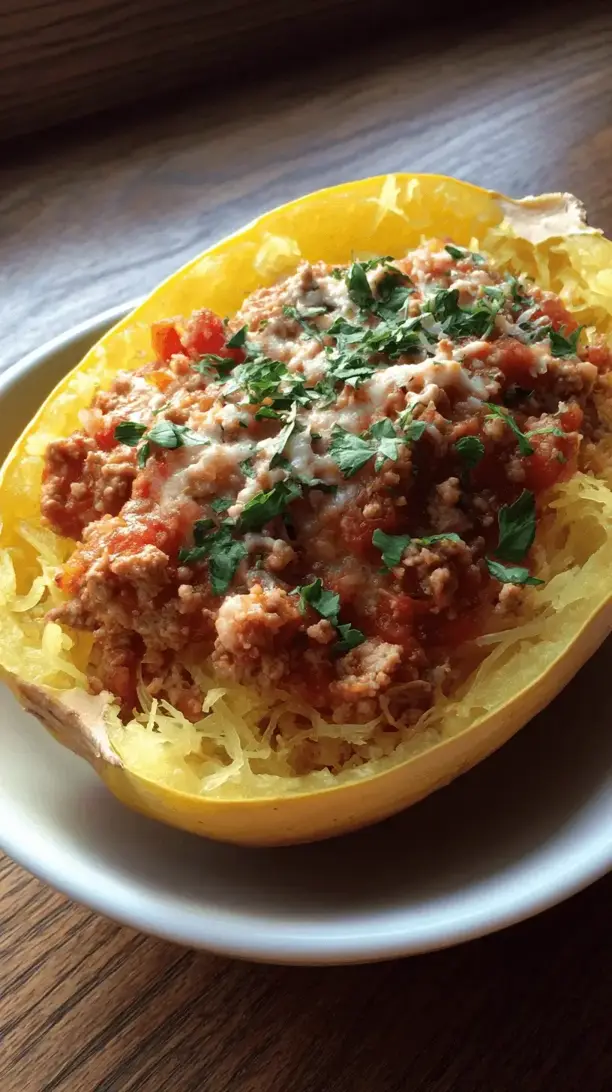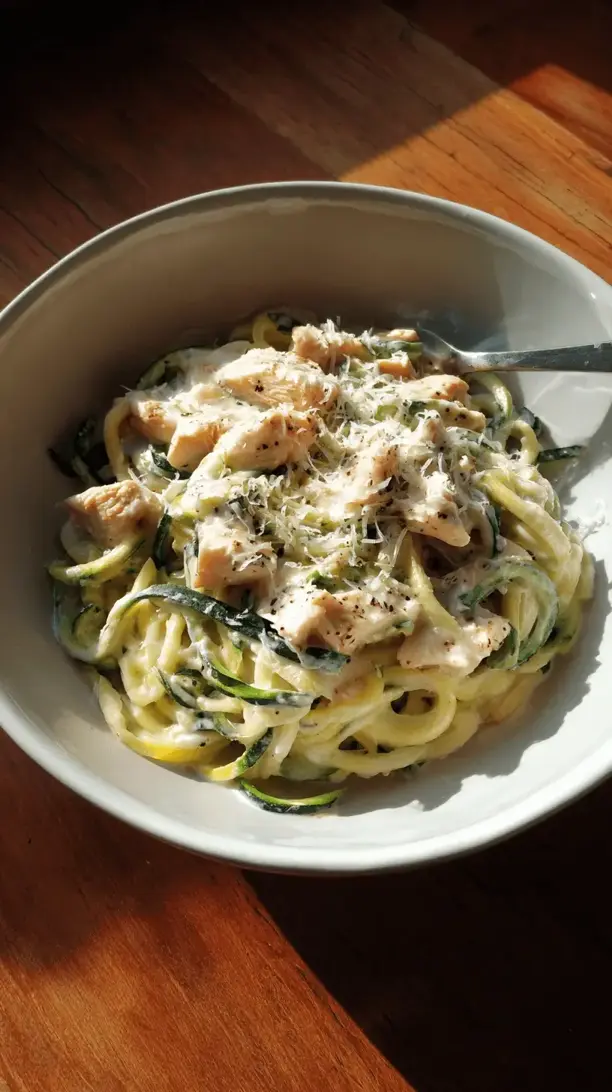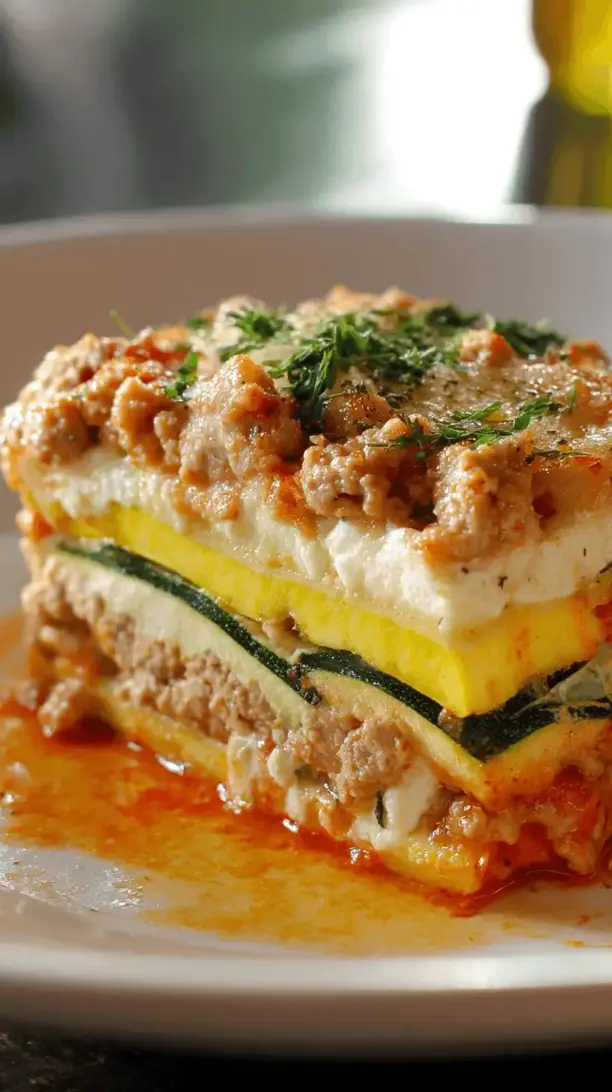Why You’ll Love This Spaghetti Squash with Turkey Bolognese
- It’s a total comfort food makeover. You get all the cozy, satisfying feelings of a classic spaghetti dinner, but with a nutrient-packed vegetable base and lean protein. It’s the kind of meal that makes you feel good from the inside out.
- The texture is honestly fantastic. Roasted spaghetti squash has a lovely, slightly al dente bite that holds its own against the robust sauce. It’s not trying to *be* pasta—it’s celebrating its own unique, delicious qualities.
- It’s a meal prep dream. Both the roasted squash and the Bolognese sauce reheat beautifully, making for incredible lunches all week long. The flavors actually meld and improve after a day or two in the fridge.
- It’s surprisingly simple to pull off. While the sauce benefits from a little gentle simmering, the active hands-on time is really minimal. It’s mostly about letting the stove and oven do their thing while you enjoy the wonderful smells.
Ingredients & Tools
- 1 large spaghetti squash (about 3-4 lbs)
- 1 tbsp olive oil, plus more for drizzling
- 1 yellow onion, finely diced
- 2 carrots, finely diced
- 2 celery stalks, finely diced
- 4 cloves garlic, minced
- 1 lb lean ground turkey
- 1/2 cup dry red wine (like a Chianti or Pinot Noir)
- 1 (28 oz) can crushed tomatoes
- 2 tbsp tomato paste
- 1 cup chicken or vegetable broth
- 1 tsp dried oregano
- 1 bay leaf
- 1/2 cup whole milk or half-and-half
- Kosher salt and freshly ground black pepper
- Fresh basil or parsley, for garnish
- Parmesan cheese, for serving
Tools: A large, sharp chef’s knife, a sturdy baking sheet, a large skillet or Dutch oven (something with high sides is ideal), a wooden spoon.
A little note on the ingredients: don’t skip the “soffritto”—that’s the onion, carrot, and celery base. It’s the secret to building deep, complex flavor. And the splash of milk at the end? It’s a classic Bolognese move that tames the acidity of the tomatoes and gives the sauce a lovely, velvety richness.
Serves: 4 | Prep Time: 20 minutes | Cook Time: 1 hour | Total Time: 1 hour 20 minutes
Before You Start: Tips & Ingredient Notes
- Choosing your squash. Look for a spaghetti squash that feels heavy for its size and has a firm, pale yellow rind without any soft spots. A larger squash is easier to work with and will yield more “noodles.”
- The power of a good dice. When you’re chopping the onion, carrot, and celery, try to get them all to a similar, small size. This isn’t just for looks—it ensures they all cook at the same rate, creating a sweet, unified flavor base for your sauce.
- Don’t fear the wine. If you’re avoiding alcohol, you can substitute with an additional 1/2 cup of broth. But honestly, the wine adds a wonderful depth and complexity that’s hard to replicate. The alcohol cooks off, leaving just its rich flavor behind.
- Turkey talk. I prefer using 93% lean ground turkey for this. It has just enough fat to keep the sauce moist and flavorful without being greasy. If you use 99% lean, just be extra careful not to overcook it initially.
How to Make Spaghetti Squash with Turkey Bolognese
Step 1: Roast the Squash. First, preheat your oven to 400°F (200°C). This is the trickiest part—safely cutting the squash. Carefully use a large, sharp knife to slice the spaghetti squash in half lengthwise. Scoop out the seeds and stringy pulp with a spoon—it’s a lot like cleaning out a pumpkin. Drizzle the cut sides generously with olive oil and season well with salt and pepper. Place the halves cut-side down on a baking sheet lined with parchment paper. Roast for 35-45 minutes, or until the flesh is very tender and easily pierced with a fork.
Step 2: Start the Soffritto. While the squash roasts, start your sauce. Heat 1 tablespoon of olive oil in your large skillet or Dutch oven over medium heat. Add the diced onion, carrot, and celery with a pinch of salt. Cook, stirring occasionally, for about 8-10 minutes, until the vegetables have softened and the onion is translucent. You’ll notice the most amazing sweet aroma starting to fill your kitchen.
Step 3: Brown the Turkey. Push the vegetables to the side of the pan and add the ground turkey. Increase the heat to medium-high. Use your wooden spoon to break the turkey into small crumbles as it cooks. Let it get some good color—this browning equals flavor! Cook until it’s no longer pink, about 5-7 minutes. Then, stir in the minced garlic and tomato paste and cook for one more minute until fragrant.
Step 4: Deglaze and Simmer. Now for the fun part! Pour in the red wine, scraping the bottom of the pan with your spoon to lift up all those delicious browned bits. Let the wine bubble and reduce by about half. This only takes a minute or two. Then, stir in the crushed tomatoes, broth, dried oregano, and the bay leaf. Bring the sauce to a simmer, then reduce the heat to low. Partially cover the pot and let it gently bubble away for at least 30 minutes—though 45 minutes to an hour is even better for deeper flavor.
Step 5: Shred the Squash. Once the squash is cool enough to handle, use a fork to scrape the flesh. You’ll see it magically separate into long, spaghetti-like strands. Transfer all the “noodles” to a bowl and fluff them up a bit with a fork. Season lightly with a pinch of salt.
Step 6: Finish the Sauce. When your sauce has simmered to your liking, remove the bay leaf. Stir in the whole milk or half-and-half—this is what gives it that authentic, velvety Bolognese texture. Taste the sauce and adjust the seasoning with more salt and pepper as needed. Let it heat through for another minute.
Step 7: Assemble and Serve. To serve, divide the warm spaghetti squash strands among four bowls. Ladle a generous amount of the turkey Bolognese over the top. Finish with a shower of freshly grated Parmesan cheese and a sprinkle of chopped fresh basil or parsley. The contrast of the fresh herbs with the rich sauce is just perfect.
Serving Suggestions
Complementary Dishes
- A simple arugula salad — The peppery bite of arugula dressed with just a squeeze of lemon juice and a drizzle of olive oil cuts through the richness of the Bolognese beautifully.
- Garlicky sautéed greens — A side of kale or Swiss chard cooked with a little garlic and red pepper flakes adds a wonderful earthy component and a pop of vibrant green color to the plate.
- Crusty, whole-grain bread — Absolutely essential for mopping up every last bit of sauce from the bowl. A warm, toasty slice is the perfect companion.
Drinks
- A medium-bodied red wine — A Sangiovese or a lighter-style Chianti has enough acidity to complement the tomatoes without overpowering the delicate turkey and squash.
- Sparkling water with lemon — For a non-alcoholic option, the bubbles and citrus are incredibly refreshing and help cleanse the palate between bites.
- A light Italian beer — A crisp pilsner or a Peroni would work wonderfully, its carbonation and mild bitterness balancing the savory notes of the dish.
Something Sweet
- Dark chocolate almond clusters — A few pieces of something dark and not-too-sweet after this meal feels just right. The bitterness of the chocolate is a lovely contrast.
- Lemon sorbet — Incredibly light and palate-cleansing. The sharp, bright citrus is the perfect finale after a rich, savory dinner.
- Simple almond biscotti — You can dip them in a little dessert wine or coffee, but they’re also delicious on their own for a subtle, nutty finish.
Top Mistakes to Avoid
- Mistake: Underseasoning the squash. The squash itself is quite mild, so it really needs that initial seasoning with salt and pepper before roasting. If you forget, the final dish can taste a bit bland.
- Mistake: Rushing the vegetable sauté. If you don’t give the onion, carrot, and celery enough time to soften and sweeten, you’ll miss out on the foundational flavor of the sauce. Be patient here—it’s worth it.
- Mistake: Boiling the sauce aggressively. A gentle simmer is what you want. A rolling boil can make the tomatoes taste tinny and cause the sauce to reduce too quickly, potentially making the turkey dry.
- Mistake: Overcooking the squash. If you roast it for too long, the strands can become mushy and watery. You’re looking for tender, separate strands that still have a little bite.
Expert Tips
- Tip: Microwave the squash first. If wrestling with a hard squash makes you nervous, poke the whole squash a few times with a knife and microwave it for 3-4 minutes. This softens the skin just enough to make cutting it in half much, much easier.
- Tip: Use an ice cream scoop. For the cleanest, easiest way to scoop out the seeds and pulp from the squash halves, an ice cream scoop is your best friend. It’s the perfect shape and strength for the job.
- Tip: Let the sauce rest. Bolognese is one of those sauces that often tastes even better the next day. If you have the time, make the sauce ahead, let it cool, and reheat it gently when you’re ready to serve. The flavors will have melded beautifully.
- Tip: Don’t crowd the baking sheet. If your squash halves are very large, use two baking sheets. If they’re crammed on one, they’ll steam instead of roast, and you won’t get those lovely caramelized edges.
FAQs
Can I make this recipe vegetarian?
Absolutely! It’s a very easy swap. Instead of ground turkey, use a plant-based ground “meat” alternative or about 2 cups of cooked brown lentils. For the broth, just make sure you’re using vegetable broth. The cooking process remains exactly the same, and you’ll still end up with a deeply flavorful, hearty sauce that’s perfect over the squash.
How do I store and reheat leftovers?
Store the squash and the sauce separately in airtight containers in the fridge for up to 4 days. To reheat, I find it best to warm the sauce in a saucepan over medium-low heat, adding a tiny splash of water or broth if it’s thickened up too much. You can reheat the squash in the microwave in 30-second bursts, or quickly in a skillet to evaporate any excess moisture. Then, just combine and enjoy!
My squash is very watery. What did I do wrong?
This can happen if the squash is over-roasted or if it was a particularly watery one to begin with. Don’t worry! After you’ve shredded the squash with a fork, you can place it in a clean kitchen towel or a few layers of paper towels and gently squeeze out the excess liquid. This step makes a huge difference and ensures your final dish isn’t soggy.
Can I freeze the Bolognese sauce?
Yes, the turkey Bolognese sauce freezes exceptionally well. Let it cool completely, then transfer it to a freezer-safe container or bag. It will keep well for up to 3 months. Thaw it overnight in the refrigerator before reheating. I don’t recommend freezing the cooked spaghetti squash, as it becomes very mushy and watery upon thawing.
What can I use instead of wine?
If you prefer not to cook with wine, you have a couple of great options. You can simply omit it and add an extra 1/2 cup of broth. For a bit of complexity, you could also add a tablespoon of balsamic vinegar along with the broth—it will give a similar sweet-and-tangy depth that mimics the role of the wine in the sauce.



